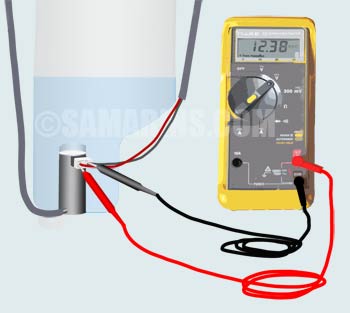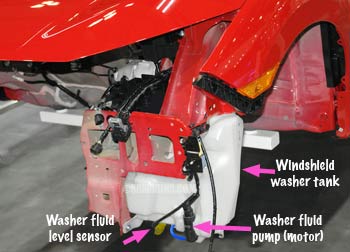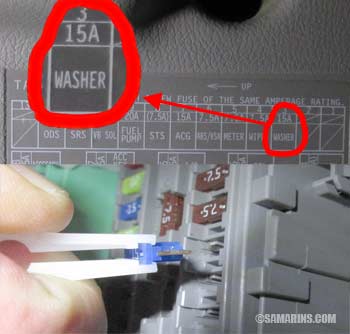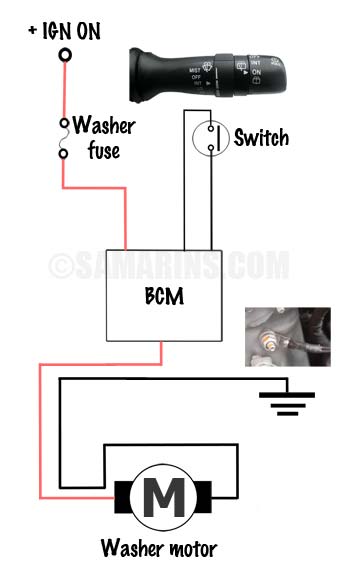Windshield washer pump: how it works, symptoms, problems, testing
Updated: August 14, 2021
In modern cars, the windshield washer pump comes as one unit with a small electric motor. Typically, the windshield washer pump is installed in the lower portion of the windshield washer fluid tank (reservoir).
In most cars, the windshield washer tank is located behind the front bumper, in front of one of the front wheels; see the illustration. How it works: When you operate the washer with the switch, it sends the signal to the control module (e.g. BCM) that, through the relay, operates the windshield washer pump. The pump pumps the windshield washer fluid through the hoses that are connected to the washer jets.
Windshield washer pump problems
One of the common problems is when the windshield washer pump electric motor fails and doesn't run when activated by the switch. In some cases, the pump fails, so you can hear the motor running when the washer switch is operated, but the washer fluid doesn't spray. A bad windshield washer pump (motor) must be replaced.A leaking or pinched fluid hose can also cause the washers not to work even when the washer pump is running. The symptom of a disconnected hose is the washer fluid leaking somewhere under the car when the washer pump is operated.
Due to its location, the washer fluid tank is also prone to damage or cracks that can cause the fluid to leak out. Another common problem in below-freezing temperatures is when the fluid in the washer tank freezes, read more: Windshield Washer not Working: 5 Common Causes.
Windshield washer pump replacement
Replacing the windshield washer pump (motor) is not very difficult if there is good access to its location. In most cars, the pump just pops out and the new pump pops in into the rubber sleeve installed in the fluid reservoir.The key to replacing the pump is to remove it carefully without damaging the rubber sleeve. If the rubber sleeve is dry, spraying a silicone lubricant will help. The new windshield washer pump (motor) costs from $15 to $35. A repair shop may charge you $50-$150 labor to replace it. The diagnostic fee is usually separate.
The windshield washer fluid freezes in cold temperatures
This happens when the summer windshield washer fluid is left in the washer fluid bottle. When the temperature drops, the summer fluid freezes. The solution is to bring the car inside a warm garage and let the ice melt. It may take several hours. Some people pour warm water on the sides of windshield washer bottle to melt the ice in it.Once the fluid melts and the washer pump starts working, use up the old fluid and refill the bottle with the winter-grade windshield washer fluid. The fluid can freeze not only in the bottle, but in the hoses and in the washer jets as well.
How the windshield washer pump (motor) is tested
When you press the washer switch, the pump (motor) is powered by the 12 Volt battery power. It only works when the ignition is ON or when the engine is running. If you don't hear the washer pump running when operating the washer switch, the first step is to check the fuse. You can find the location of the fuse on the fuse box cover or in the owner's manual.The fuse says "Washer," see the photo. In most cars there are at least two fuse boxes. One is located under the hood; the other one is inside the car. In this Honda in the photo the in-cabin fuse box is located above the left front kick panel. See: How to Check a Fuse in a Car. If the fuse is OK, the voltage at the motor needs to be checked. See the next step.
 There is 12V at the connector. If the connector is not corroded and the motor doesn't run, the motor is bad.
There is 12V at the connector. If the connector is not corroded and the motor doesn't run, the motor is bad.Why the voltage needs to be checked with the connector still connected: This way, if one of the wires is corroded, the multimeter will show low or no voltage. If you measure the voltage when the connector is disconnected, even if one of the wires is badly corroded it will still show 12 Volt. This is because there is no load and therefore no current in the circuit.
When the switch is operated, there is no voltage at the motor
If there is no or low voltage at the pump when the switch is activated, the electric circuit must be checked. The washer pump (motor) circuit is simple: The multifunction switch sends the signal to the body control module or BCM. In some cars, the control module might have a different name, for example, in some Hondas it's called MICU. The control module supplies the 12 Volt power to the relay or directly to the pump (motor).If there is no power at the motor, the voltage must be checked at the connector at the control module.
There could also be another connector between the windshield washer motor and the control module. Since in many cars, it is located behind the front bumper or in the wheel well, it is prone to corrosion damage. If there is no power at the control module, the power at the switch must be checked. The switch operation can also be checked with a scan tool that can access the BCM.
The ground terminal is another important point that must be checked. A loose or corroded ground terminal is one of the most common reasons for many hard-to-diagnose electrical problems.
Read Next:
Wiper motor, linkage: how it works, symptoms, problems, testing
How to check a fuse
Car won't start: 3 common causes. Steps to diagnose
Starting system, starter motor: problems, How the starting system is tested
Timing belt: when should it be replaced, what happens if it breaks
Check Engine light: what to check, common problems, repair options
Wiper motor, linkage: how it works, symptoms, problems, testing
How to check a fuse
Car won't start: 3 common causes. Steps to diagnose
Starting system, starter motor: problems, How the starting system is tested
Timing belt: when should it be replaced, what happens if it breaks
Check Engine light: what to check, common problems, repair options



